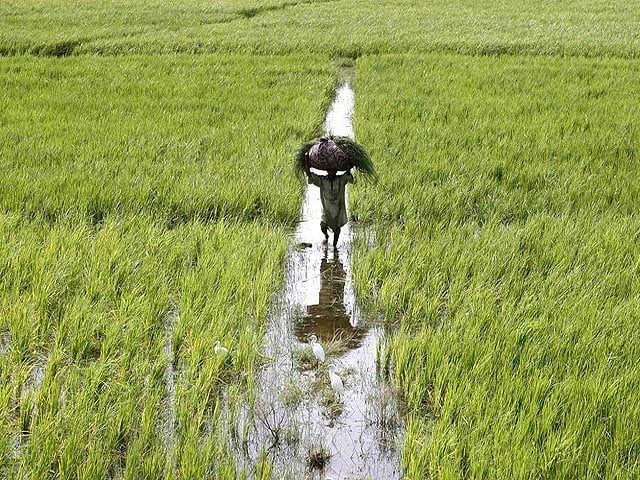An unyielding year for agriculture in Pakistan
Floods, incompetence and inflation continue to afflict the sector

Agriculture, the backbone of Pakistan’s rural economy, has been hit hard in 2022, especially due to the impact of the devastating floods.
The other reasons remain the same: incompetence, bad governance and the spectre of ever-increasing inflation.The effect of these factors has raised alarm bells when it comes to predicting the state of the agriculture sector and feeding the people of Pakistan for the next year.
The Economic Survey of Pakistan 2021-22 presented an encouraging scenario; it said that the agriculture sector posted a 4.4% growth in 2021-22 against 3.4% in the corresponding year. Except the wheat crop, all other crops have shown impressive growth.
In the current fiscal year, floods hit most of the country, thereby damaging the kharif crops. There are a few estimates made by the Planning Commission of Pakistan and some independent think-tanks to determine the level of economic damage to the agricultural sector.
The Planning Commission of Pakistan, in its report, said that the floods have damaged agriculture and its sub-sectors to the tune of Rs800 billion or $3.725 billion. Around 1,784,126 hectares (4,408,575 acres) of agricultural land have become derelict and over 800,000 animals have died in the six affected provinces and their 94 districts.
Crops contributed to 82% of the total damage and losses in the sector, followed by livestock with 17% and fisheries/aquaculture accounting for the remaining 1%. Sindh and Balochistan are the most affected provinces, contributing 72% and 21% respectively to the total value of damage and losses registered in the sector, followed by Khyber Pakhtunkhwa, Punjab, and special regions.
The destruction of the crops, livestock and aquaculture infrastructure and assets has resulted in the temporary deterioration of livelihoods, employment and agriculture related income, as well as the potential decline in the export of important crops such as cotton and sugarcane.
Overall damages are estimated to be around $3.73 billion, which translates into a loss of $9.243 billion. The Planning Commision suggested that the country needs at least $3.98 billion for the recovery of this sector. “This year, the poor performance of the agriculture sector has hit the farmers as well as the common citizens of Pakistan,” said Chaudhary Arshad, a progressive farmer from Multan.
While talking to the Express Tribune, Arshad observed that since the start of this year we have and are still undergoing ‘hyper-inflation’. “ First the change of government in April resulted in a hike in the price of basic commodities. On top of that, the rupee depreciation, high input costs and above all, a lack of governance translated into even higher prices for basic commodities,” he added.
The domestic price of essential food items, including wheat flour, rice, cooking oil, pulses, milk and meat have spiked since January 2022, with a sharp rise in wheat and wheat flour, pulses, vegetables, and livestock products prices during the peak of the floods in the period between July– September 2022.
“This hike is still hitting consumers. Farmers may get some assistance from the recently announced Kissan relief package but it remains to be seen if they are able to benefit from this package,” noted Arshad.
In October this year, the federal government announced a Kissan relief package of Rs1,800billion.Thescopeofthispackageis to provide farmers with subsidised fertiliser, urea and electricity, along with providing new loans and waving off interest payments on existing loans.
Such packages are a routine matter and nearly all governments announce such schemes for the betterment of the agriculture sector. Transformation, however, has rarely been observed in this sector due to such relief packages.
President of the Pakistan Businesses Forum (PBF), Chaudhry Ahmad Jawad said that Pakistan’s agriculture sector suffered major setbacks in the year of 2022.
“Rocket inflation, high input prices, high electricity tariff and then floods have put a heavy dent on the country’s agriculture sector. The same situation is likely to continue in 2023, if direct subsidies are not given on the key inputs of the agriculture sector,” emphasised Jawad.
However, farmers did get some relief in the form of electricity tariffs for agricultural tube-wells from the National Electric Power Regulatory Authority (Nepra). The authority reduced the tariff by Rs3.6 per unit yesterday (Tuesday, December 27), but that effect may be witnessed from 2023 onwards.
Jawad also stated that the “government needs to take a series of governance reforms and technology interventions to uplift the financial and social status of the agriculture-dependent populations.”
“There are over a dozen key areas where government attention is required, including devising a legal framework to improve the purchasing power of small-holders, enabling them to get farm inputs without being exploited by market forces,” he added.
“The farmers’ poverty should be taken care of because a lack of resources makes them vulnerable to exploitation from powerful individuals and institutions,” warned Jawad.
Government agencies also predicted that high loss of food stocks in affected areas will continue to contribute to reduced supplies and high demand. Expected delays in the sowing of rabi crops, particularly the taple wheat crop, could reduce the availability of food in the coming months. This will continue to increase the prices of basic food commodities and make access to food more difficult, particularly for low-income groups in hard hit areas.
Government estimates suggest that the population of food insecure citizens will increase from seven million people to 14.6 million in the calamity-stricken districts.



















COMMENTS
Comments are moderated and generally will be posted if they are on-topic and not abusive.
For more information, please see our Comments FAQ